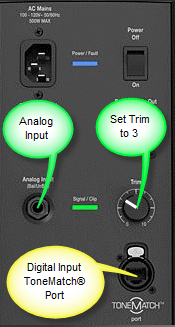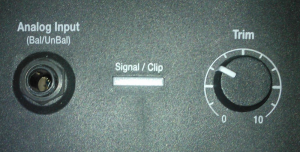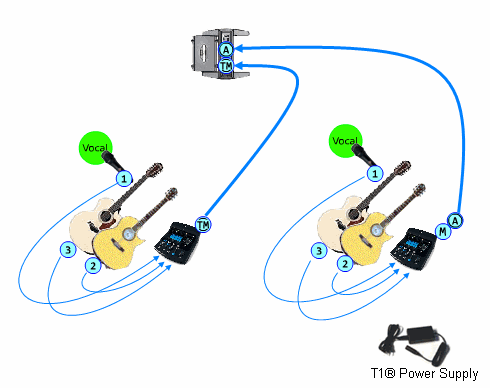Difference between revisions of "Duo"
m (first ed) |
m (Duo with two Classics / Model Is) |
||
| Line 3: | Line 3: | ||
<br> | <br> | ||
| − | == Ideal Application: One {{L1 nl}} per Performer == | + | == Ideal Application: One {{L1 nl}} per Performer == |
| − | |||
| − | {{ | + | Running one {{L1 nl}} for each performer in a duo format is a wonderful experience for both the performers and the audience. This gives the audience all the benefits of localization, and the best possible monitoring experience for the performers. |
| + | === Model I / Classic === | ||
| + | {{#Click:Stage Layouts / ST Duo Classic / Model I|Image:STDuoModelIClassic.png||ST Duo with Model I / Classics}} | ||
| + | |||
| + | |||
| + | |||
| + | === Model II === | ||
| + | {{#Click:Stage Layouts / ST Duo|Image:STDuoModelII.png||ST Duo with Model IIs}} | ||
| + | |||
| + | <br> | ||
== Connecting Two {{T1 nl}} to a {{Model II}}<br> == | == Connecting Two {{T1 nl}} to a {{Model II}}<br> == | ||
| Line 17: | Line 25: | ||
---- | ---- | ||
| − | <br><br> [[Category:Application_Guide]] | + | <br><br> |
| + | |||
| + | [[Category:Application_Guide]] | ||
Revision as of 17:41, 6 December 2008
This is an application guide for people who use their L1® in a duo format.
Contents
Ideal Application: One L1® per Performer
Running one L1® for each performer in a duo format is a wonderful experience for both the performers and the audience. This gives the audience all the benefits of localization, and the best possible monitoring experience for the performers.
Model I / Classic
{{#Click:Stage Layouts / ST Duo Classic / Model I|Image:STDuoModelIClassic.png||ST Duo with Model I / Classics}}
Model II
{{#Click:Stage Layouts / ST Duo|Image:STDuoModelII.png||ST Duo with Model IIs}}
Connecting Two T1 ToneMatch® Audio Engine to a L1 Model II
The L1 Model II can accept two inputs.
This makes it easy for two performers to connect their own T1®s to a L1® Model II Power Stand.
ToneMatch® Input
The ToneMatch® connection is specifically designed for a T1 ToneMatch Audio Engine. The ToneMatch® cable is supplied with the T1 ToneMatch Audio Engine and uses a male Ethercon connector at both ends.
Analog Input
The Analog connection is a ¼ inch phone jack. You can use this for a second T1® using the T1® Analog Master output (¼ inch phone jack).
This connection is made with a standard ¼ inch jack instrument cable. This can be Tip-Sleeve or Tip-Ring-Sleeve connectors.
Set Power Stand Analog Input Trim to 3 to have approximately the same level as you would have if you had connected with the ToneMatch® connection. You may have to adjust this, but 3 is a good place to start.
Note: A T1® connected to the the Analog input will require the optional T1 ToneMatch® Audio Engine power supply.
Analog Connection from the Second T1® to the Model II Power Stand
¼ Inch Tip-Ring-Sleeve (balanced) to ¼ Inch Tip-Ring-Sleeve (balanced)
A balanced connection is preferred and will provide better noise rejection over greater distances than the unbalanced connection.
¼ Inch Tip-Ring-Sleeve (unbalanced) to ¼ Inch Tip-Sleeve (unbalanced)
This should work fine but a balanced connection (immediately above) is preferred especially if you will have cable runs in excess of 20 feet (6 meters) or if you hear line noise, hum or hiss.


